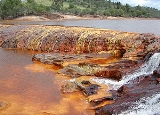
Iron
Overview
Chemical element
A chemical element is a pure chemical substance consisting of one type of atom distinguished by its atomic number, which is the number of protons in its nucleus. Familiar examples of elements include carbon, oxygen, aluminum, iron, copper, gold, mercury, and lead.As of November 2011, 118 elements...
with the symbol Fe (from ) and atomic number
Atomic number
In chemistry and physics, the atomic number is the number of protons found in the nucleus of an atom and therefore identical to the charge number of the nucleus. It is conventionally represented by the symbol Z. The atomic number uniquely identifies a chemical element...
26. It is a metal
Metal
A metal , is an element, compound, or alloy that is a good conductor of both electricity and heat. Metals are usually malleable and shiny, that is they reflect most of incident light...
in the first transition series. It is the most common element (by mass) forming the planet Earth as a whole, forming much of Earth's outer
Outer core
The outer core of the Earth is a liquid layer about 2,266 kilometers thick composed of iron and nickel which lies above the Earth's solid inner core and below its mantle. Its outer boundary lies beneath the Earth's surface...
and inner core
Inner core
The inner core of the Earth, its innermost hottest part as detected by seismological studies, is a primarily solid ball about in radius, or about 70% that of the Moon...
. It is the fourth most common element in the Earth's crust
Abundance of elements in Earth's crust
The table shows the abundance of elements in Earth's crust. Numbers show percentage or parts per million in mass; 10,000 ppm = 1%.Note that numbers are estimates, and they will vary depending on source and method of estimation. Order of magnitude of data can roughly be relied upon.The table shows...
. Iron's very common presence in rocky planets like Earth is due to its abundant production as a result of fusion in high-mass stars, where the production of nickel-56 (which decays to iron) is the last nuclear fusion reaction that is exothermic
Exothermic
In thermodynamics, the term exothermic describes a process or reaction that releases energy from the system, usually in the form of heat, but also in the form of light , electricity , or sound...
.

